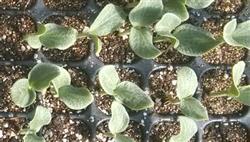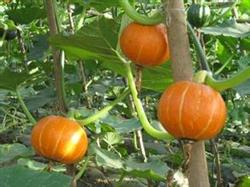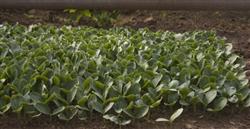Cultivation techniques of early ripening Japanese Pumpkin in Spring

Japanese pumpkin, also known as western pumpkin, is a new type of vegetable pumpkin introduced from Japan, South Korea and other places as a high-quality pumpkin in recent years. This kind of pumpkin has compact and meticulous meat, sticky or powdery, excellent flavor and small fruit shape. Generally, when it is harvested as a vegetable, its single melon weighs 1 kg; it is early in maturity and stable in fruit, so it is one of the main vegetables cultivated in greenhouse. 1. Requirements of growth and development of Japanese pumpkin on environmental conditions Japanese pumpkin is a temperature-loving crop with a growth temperature of about 25 ℃ and its high temperature tolerance is not as good as that of ordinary pumpkin. When the temperature is 32 ℃, the growth is poor. Japanese pumpkin has a good tolerance to low temperature, and the lowest temperature for growth and development is 6 Mel 8 ℃. It can bloom normally under the condition of 15 ℃. But above 38 ℃, these pumpkins cannot blossom and develop normally. The root system of pumpkin is well developed, and a large root group is formed in the later stage of growth. the main root can be up to 100 cm deep, and most of the roots are distributed in about 15 cm. Pumpkin is a short-day crop, lower temperature and short-day light can promote the production of female flowers. Generally in spring, early sowing can blossom early, and when most varieties are sown in spring, the main vine can blossom in about 13Mel 14 nodes. Japanese pumpkin has higher requirements for sunshine. Under the condition of low light, the leaves are yellowish and there are often melons, which should be paid attention to. Second, cultivation techniques 1. Varieties require Huibishou from Japan, Dongsheng from Taiwan, Jinyuan from South Korea, Tian Fu from Shanghai, Jinli from Hunan, sweet chestnut from Zhejiang and so on. two。 Sowing and seedling cultivation in the greenhouse in the Yangtze River basin can generally start sowing in late December and planting in February. The cultivation in small arch shed can be sowed from late January to early February and planted at the end of March. Soak the seeds for 24 hours before sowing, and then sprout. When sprouting, cover the seeds with a wet towel and place them in a hotbed of 25Mel 28 ℃. On the third day, when the buds grow 4mm, they are sown in a pre-prepared seedling bowl (10Mel 12cm in diameter). The seeds can also be soaked and sowed directly into the seedling bowl and placed in the hotbed to raise seedlings. The temperature of the seedling bed is controlled at about 25 ℃, and then buckle up with a small arch shed to keep warm and moisturize to promote the seedling. After emergence, the temperature was gradually reduced to 20 ℃ 25 ℃ during the day and 15 ℃ at night. When the seedlings have 3 true leaves, the distance between the bowl and the bowl should be increased to prevent the seedlings from growing. At this time, the seedlings enter the flower bud differentiation stage. If the seedlings are covered with a sunshade net from 16:00 to 8 o'clock the next day, the node position of the female flowers can be reduced. The age of the seedlings was 40 Mel for 45 days, and the seedlings were colonized when they had 5 true leaves. 3. Land preparation should be completed 10 days before planting with basic fertilizer. In each standard shed, 600 kg of mature organic fertilizer was applied, and 25 kg (15mur15 / 15) ternary compound fertilizer was applied as base fertilizer, and then the bed was made. It is generally made into ditches 120 cm wide and 60 cm wide. Each shed is made into three rows, spread the eyedropper and plastic film in advance, buckle the small arch and wait for the soil temperature to rise. 4. Before planting, the seedling bed should be planted with 75% chlorothalonil or 70% mancozeb once, and 5 tablets of ternary compound fertilizer should be put in each nutrition bowl to achieve colonization with fertilizer and medicine. For those who set up scaffolding, they are generally planted in 2 rows per row, with a plant spacing of 50 cm, and 400 plants can be planted in each standard shed. 5. Field management (1) within 7 days after temperature management, sealed management was adopted in the small arch shed to increase temperature and promote seedlings. After returning the seedlings, it kept 25 ℃ 28 ℃ during the day and 15 ℃ at night. When it is higher than 32 ℃, it should be ventilated and cooled down. (2) the plant is adjusted to set up when the vine length is 60 cm. The upright orchid frame or "human" frame is adopted to promote cross-drawing on the shelf. Pruning in time, the way depends on the density, there is a vine, there is also a main side. Each plant generally leaves 3 melons and leaves 8 leaves at the top of the fruit. In addition, the old leaves at the base of the plant should be removed before and after harvest to improve ventilation and light transmission and reduce diseases. (3) Fertilizer and water management in the early stage of growth, only apply some root fertilizer (1% urea solution or 10% mature dung) at the time of planting, and no more topdressing. After waiting for the head melon to sit down, it should be fertilized in time, 7kg / standard shed. After harvesting, 5kg compound fertilizer was applied in 3Mel, and then fertilized according to the situation. (4) artificial pollination is generally carried out to promote fruit setting. The pollination time occurs when the sun comes out in the morning and the male flowers can release pollen. 0.004% anti-falling hormone can also be used to promote the results in early spring. (5) the main diseases of Japanese pumpkin are quenching disease in early stage, virus disease, Sclerotinia sclerotiorum disease and powdery mildew in adult stage. The main insect pests are aphids, thrips, red spiders, ground tigers and so on. It should be prevented and treated in time. 6. After harvesting pumpkin fruit, it is necessary to go through certain growth and development in order to accumulate enough sugar and reflect the quality characteristics. In addition, the harvest period should also take into account the market situation, plant growth status, etc., in order to obtain better economic benefits.
- Prev

Cultivation techniques of Western Pumpkin in Spring greenhouse
Pumpkin is a kind of nutritious and healthy vegetable, while the western pumpkin imported from abroad has less water content, more solids, more non-reducing sugar and starch, more starch / whole sugar ratio, less crude fiber and high crude protein content. therefore, the taste and taste are good, and the quality is much better than that of domestic pumpkins.
- Next

Seedling raising techniques of stand cultivation of Pumpkin in Solar greenhouse in Winter and Spring
The sowing date of ① is mainly determined by the heat preservation of solar greenhouse. The solar greenhouse with good lighting and good heat preservation can sow seeds and raise seedlings in late November. The melon was harvested in the middle of March in the second year, on the contrary, the sowing date can be postponed to January of the following year. Using the above-mentioned solar greenhouse, generally sowing from late December to early January of the following year.
Related
- Where is it suitable to grow horseradish in China? it is expected to see the middle altitude horseradish in Alishan.
- How to prevent tomato virus disease reasonably? (Control methods included)
- Many people like to plant towel gourd on the balcony. What are the main points of this method and management?
- What crops can chili peppers be mixed with?
- Fertilization techniques and matters needing attention in Tomato
- What are the grafting techniques for peach seedlings in spring?
- Harm and control methods of root swelling disease of Chinese cabbage
- What are the pests of sweet potatoes? How to prevent and cure it?
- Symptoms, causes and Control methods of navel Rot in Tomato
- The cause of "Cucumber rotten bibcock" in Farmers' planting Cucumber and its Control Plan

